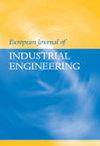优化团队和手术效果
IF 1.9
4区 工程技术
Q3 ENGINEERING, INDUSTRIAL
引用次数: 0
摘要
机器人手术的结果涉及许多因素的非线性相互作用,包括与患者相关和手术团队相关的因素。在机器人手术中,不仅外科医生,而且所有团队成员都在决定手术结果方面发挥着重要作用。因此,研究最佳手术团队配置决策具有重要意义。在这项研究中,我们通过分析机器人手术数据,研究了准确预测手术结果的回归模型。我们进一步开发了一个优化模型,通过考虑两个单独的目标来研究最佳团队配置决策:1)最大限度地减少手术室占用时间;2) 以最大限度地减少手术室的平均占用时间。在我们的数值分析中,我们将最优团队配置决策与当前配置决策进行了比较,并表明最优团队分配决策可以使手术室占用时间减少17%。我们的研究结果表明,减少手术室占用时间的努力应该集中在增加手术团队成员的经验上,例如通过运行培训计划。[提交时间:2018年9月10日;接受时间:2019年5月31日]本文章由计算机程序翻译,如有差异,请以英文原文为准。
Optimising teams and the outcomes of surgery
The outcomes of robotic surgery involve nonlinear interactions of many factors, including patient-related and surgical team-related elements. In robotic surgery, not only the surgeon but also all team members play an important role in determining surgery outcomes. Therefore, it is important to study optimal surgical team configuration decisions. In this study, we investigate regression models for accurate predictions of surgical outcomes by analysing robotic surgery data. We further develop an optimisation model to investigate the optimal team configuration decisions by considering two separate objectives: 1) to minimise the maximum operating room occupation time; 2) to minimise the average operating room occupation time. In our numerical analyses, we compare the optimal team configuration decisions with the current configuration decisions and show that the optimal team allocation decision can result in a 17% decrease in operating room occupation time. Our results suggest that efforts for reducing operating room occupation time should focus on increasing the experience of surgery team members, e.g., via running training programs. [Submitted: 10 September 2018; Accepted: 31 May 2019]
求助全文
通过发布文献求助,成功后即可免费获取论文全文。
去求助
来源期刊

European Journal of Industrial Engineering
工程技术-工程:工业
CiteScore
2.60
自引率
20.00%
发文量
55
审稿时长
6 months
期刊介绍:
EJIE is an international journal aimed at disseminating the latest developments in all areas of industrial engineering, including information and service industries, ergonomics and safety, quality management as well as business and strategy, and at bridging the gap between theory and practice.
 求助内容:
求助内容: 应助结果提醒方式:
应助结果提醒方式:


